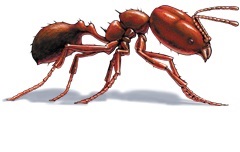Big Headed Ant ID

Characteristics
SIZE:
There are two sizes of workers in this ant group. The major workers are the larger ones, typically fluctuate in size from one-eighth of an inch inside one-fourth of an inch in length, depending on the species. It easy to identify the worker because of its extremely large size head as compared to its body. The minor workers head size seems to fit the body size of this ant.
COLOR:
Big Headed Ant color is usually reddish-brown in coloring.
BEHAVIOR:
Like all the ants, the big-headed ant water and food source is not far from the trail. You probably notice that these ants feed on different kinds of foods including dead insects, plants, and even garbage. Aphids are a source of food for the workers. They aphids produce the sweet honeydew, scales and mealybugs found feeding on many trees and plants. Fruit trees, roses and many shrubs serve as hosts for aphids and may contribute to ant infestations in homes and other buildings. One group of ants, Pheidole megacephala, establishes huge “supercolonies” composed of dozens, if not hundreds, of subcolonies interconnected by interlocking trails. These types of supercolonies have been found to extend over large portions of a city block, causing control efforts on a single property very difficult to accomplish. This type is typically seen in Florida and Hawaii but could be encountered all along the southeast Gulf Coast. They’ve been found to produce mud tubes that can look like those created by subterranean termites, though the behavior is not common.
Habitats
Big headed ants are found in the soil, under stones, inside logs and other landscaping wood materials. If you like potted plants, they may nest there as well. Usually when you find these ants in your home, they can be traced to planters in your home. In addition, you can find the big-headed ants nested inside rotted wood or will excavate old termite-damaged wood to make a nest.
Tips for Control
Due to the fact big-headed ants are soil nesters, their colonies are usually easy to see due to the piles of displaced soil created as they excavate tunnels in your yard. Most colonies are relatively smaller than average easy to treat, but treating infestations involving several colonies requires experience. Basic tips for limiting ant infestations consist of:
- Eliminating piles of lumber, bricks or other debris that could serve as a nesting site for ants.
- Maintaining landscape mulch, no more than two ins thick and at least 12 inches from the foundations.
- Ensuring the landscape sprinkler system will not spray directly onto the foundation.
- Securing as many cracks in the building’s exterior as possible.
- Maintaining tree and shrub branches trimmed down to prevent them from coming in contact with the building.